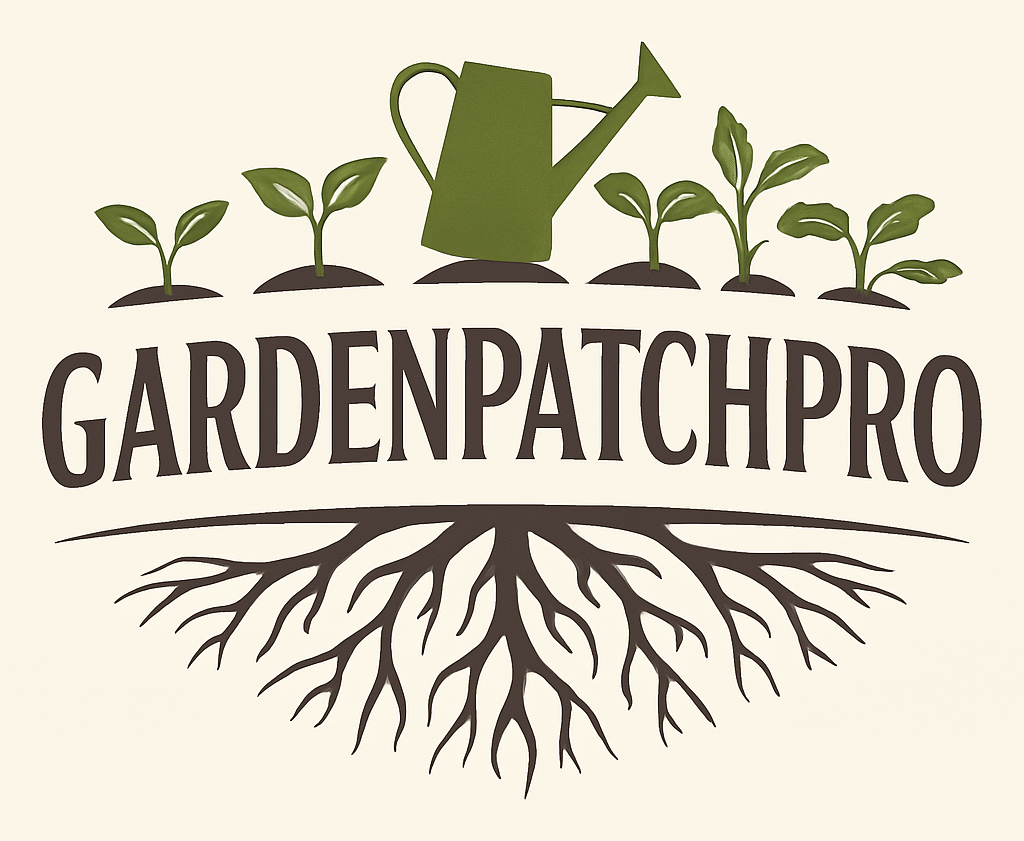16 Vertical Garden Ideas for Small Spaces and Urban Living
Vertical gardens offer a smart way to grow plants when space is tight. They use walls or other vertical surfaces to help people make the most of small areas like balconies, patios, or even indoor spots. This method can bring greenery to places that might not fit traditional garden beds.
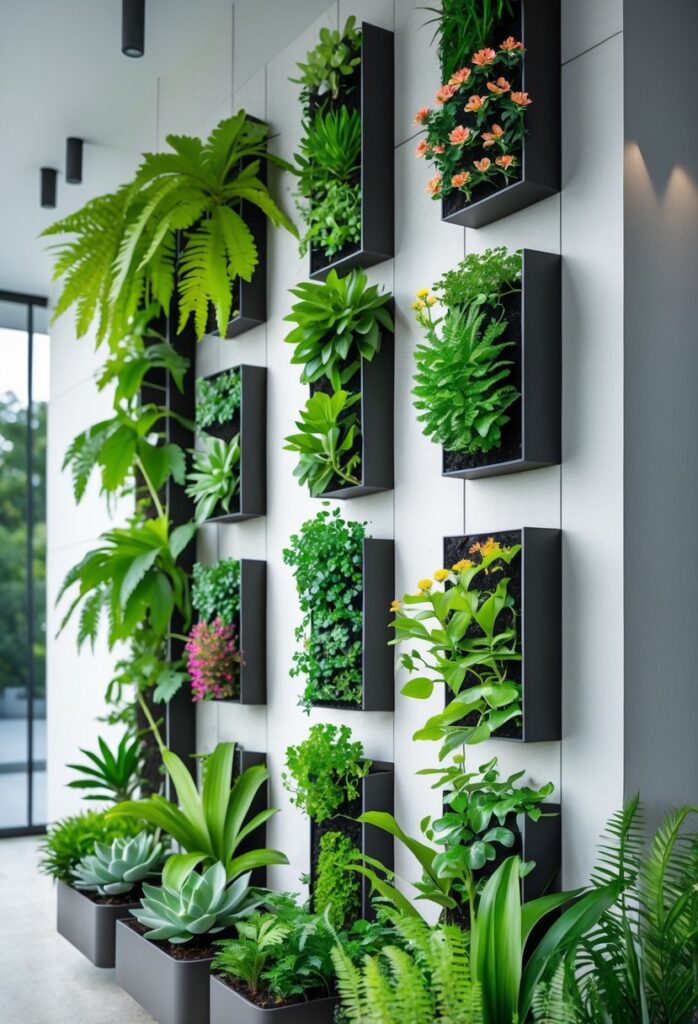
The main benefit of vertical gardens is that they maximize space while adding natural beauty and life to any environment. Many people choose this style to improve their surroundings without needing a large yard or garden area. This approach can work well for growing flowers, herbs, or even vegetables. For more ideas on setting one up, see these 16 vertical garden tips.
1) DIY Pallet Vertical Garden
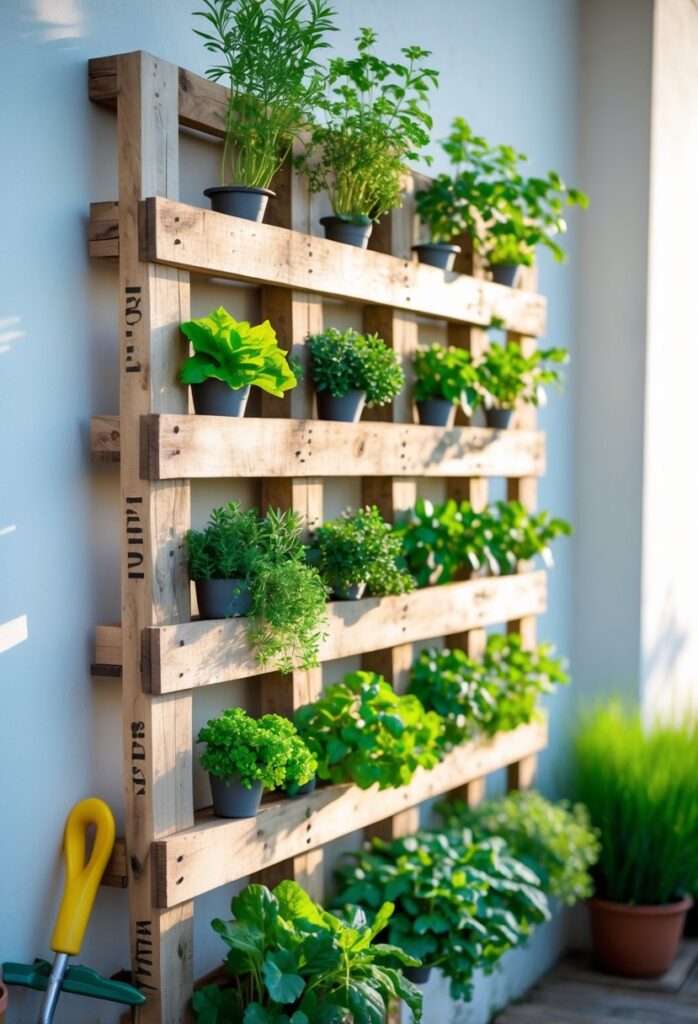
A DIY pallet vertical garden is a simple way to grow plants using old wooden pallets. It saves space and works well for small areas like balconies or patios. People often use pallets to grow herbs, flowers, and succulents.
To start, they select a sturdy pallet and check for any damage. The pallet is then lined with landscape fabric to hold soil and plants securely. After filling it with potting soil, they add plants suited for vertical growth.
This type of garden is affordable and easy to build, often taking less than an hour. It is also environmentally friendly since it reuses materials that would otherwise be discarded. Using pallets for vertical gardens is a practical choice for those with limited space wanting to grow plants creatively.
More detailed guides and step-by-step instructions can be found in a DIY vertical pallet garden tutorial.
2) Herb Wall Planter
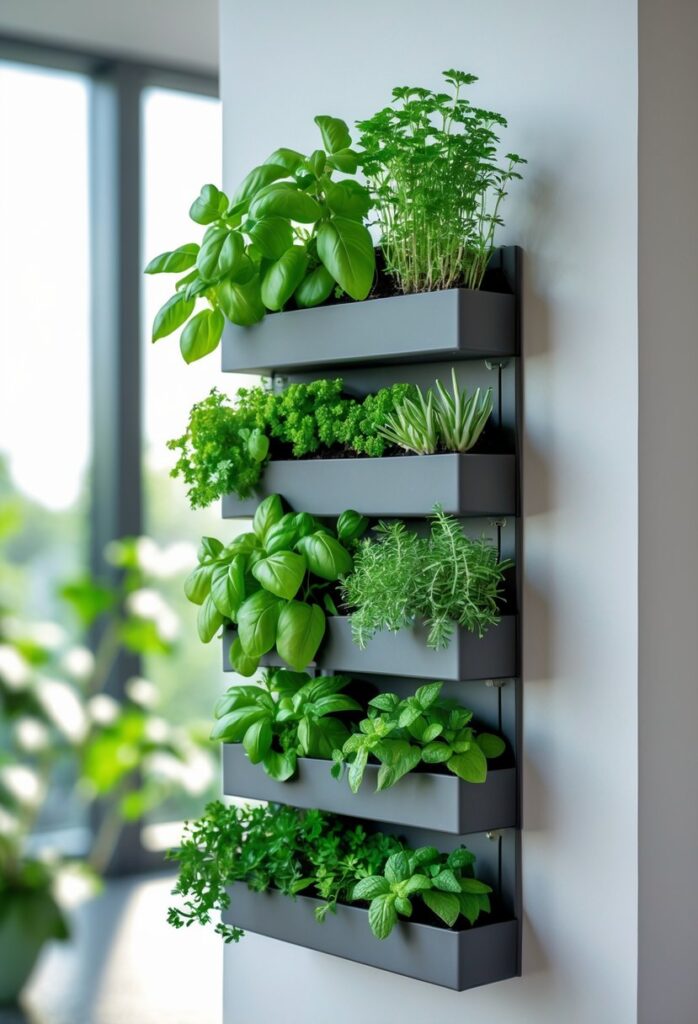
A herb wall planter is a smart way to grow fresh herbs in small spaces. It uses vertical space on walls, freeing up countertops or floors. This makes it perfect for apartments or places with limited room.
These planters often come as multi-tiered hanging systems or wall-mounted pots. They keep herbs organized and easy to access for cooking. Common herbs like basil, thyme, and rosemary grow well in these setups.
Installing a herb wall planter usually requires minimal tools and effort. Some models need only a few holes drilled into the wall. Others use hooks or brackets to hang the pots securely.
Herb wall planters can also add a touch of greenery to indoor spaces. They improve air quality and provide fresh ingredients at hand. Many versatile options are available for both indoor and outdoor use.
For those interested, there are detailed reviews and ideas for different types of herb wall planters online. Checking these can help select the best system for specific needs and space limitations. More information can be found at 4 Tiered Hanging Herb Planters Review.
3) Succulent Vertical Frame
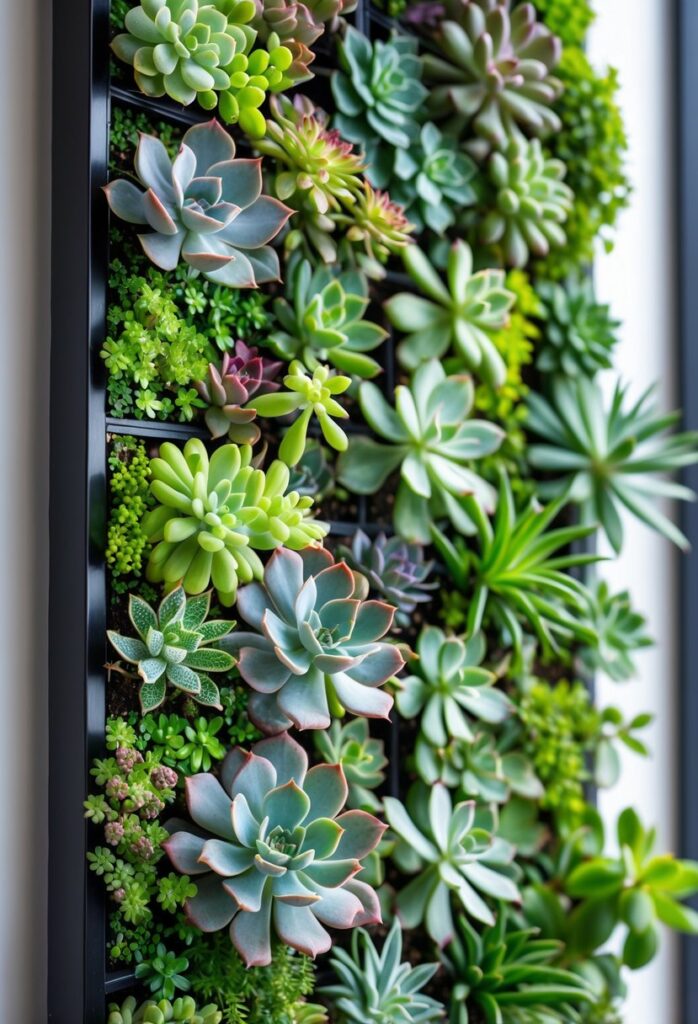
A succulent vertical frame is a popular way to display plants on a wall. It uses a shallow frame lined with a material like garden plastic or wire mesh to hold soil or moss. Succulents are planted into the frame because they need little water and soil.
The frame can be made from wood or metal, often with drainage holes at the back. This helps prevent water buildup. Succulents take root quickly and grow well in these conditions.
Frames hang easily on walls using hooks, French cleats, or wire hangers. They create a living piece of art by combining different succulent types. Colors and textures vary, making each frame unique.
Using sphagnum moss instead of soil can keep the plants secure and reduce mess. The edges of the frame can be covered with trim to hide plastic or wire, giving it a clean look.
For step-by-step guidance on making a succulent vertical frame, one can review detailed tutorials like the one from Bunnings Workshop or The Crafty Gentleman. These offer clear advice on materials and assembly.
More ideas and tips are available for those interested in vertical succulent gardens as a way to save space and add natural beauty indoors or out.
4) Trellis Climbing Veggies
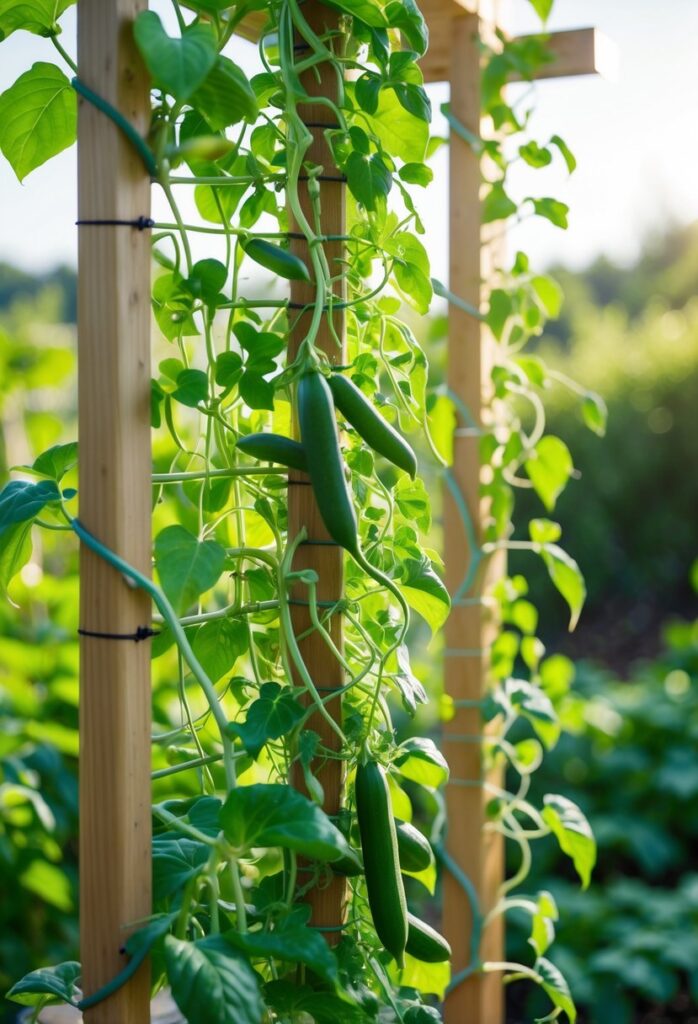
Climbing vegetables are ideal for vertical gardens. They grow upward using a trellis, saving ground space. This setup allows better air circulation and helps prevent diseases.
Common climbing veggies include cucumbers, pole beans, and peas. These plants naturally vine and need support as they grow. A sturdy trellis guides the vines and keeps the fruits off the ground.
Growing climbing vegetables on a trellis can also make harvesting easier. It keeps the plants organized and accessible. This method benefits gardeners with limited space who want to maximize their yield.
Other popular options are climbing squash, Malabar spinach, and certain varieties of tomatoes. These crops do well when given vertical support and can make a garden look fuller.
Using a trellis can improve sunlight exposure for each plant. It allows them to grow stronger and healthier by preventing overcrowding. For a list of climbing vegetables suitable for trellises, see this guide on best climbing vegetables to grow on a trellis.
5) Stacked Wooden Crate Garden
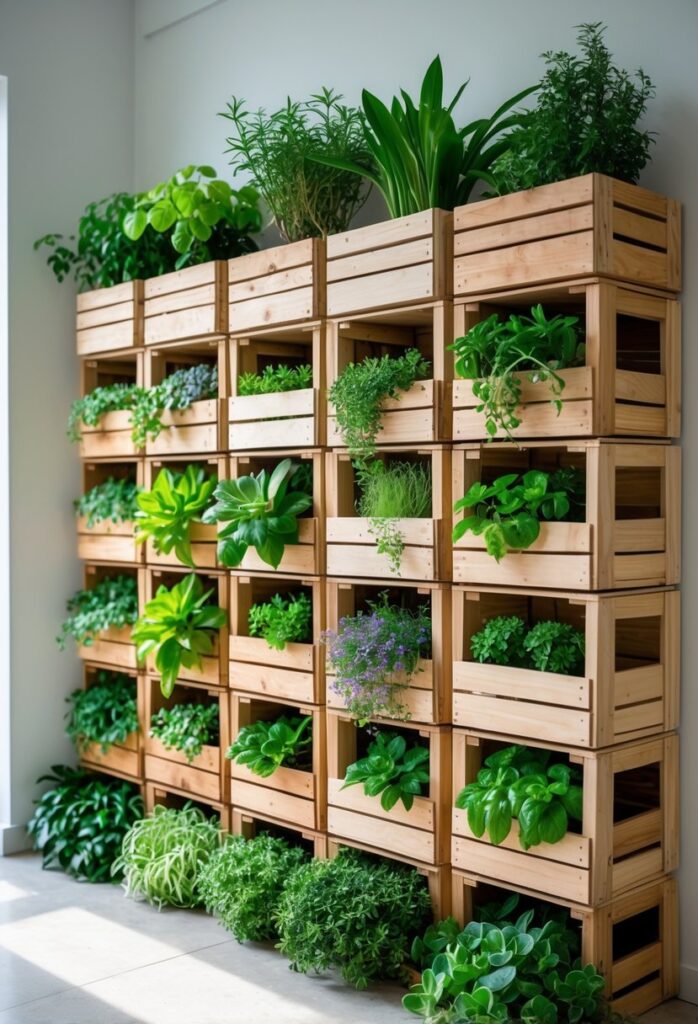
A stacked wooden crate garden is a simple and effective way to create a vertical growing space. Wooden crates can be securely stacked against a wall or fence. This setup saves ground space and adds structure to a garden area.
Each crate holds soil and plants like herbs, flowers, or small vegetables. The stack allows multiple layers of planting, making it easy to care for different plants in one spot. Proper drainage is important in each crate to avoid water buildup.
Using crates also offers flexibility. They can be rearranged or painted for a personalized look. This method is budget-friendly since crates are often inexpensive or repurposed. It works well for small balconies, patios, or tight outdoor spaces.
More ideas about making a vertical garden with wooden crates can be found at Bloomy Heaven’s guide on creative wooden crates garden ideas. This approach balances practical gardening needs with a neat, organized appearance.
6) Hanging Pocket Planters
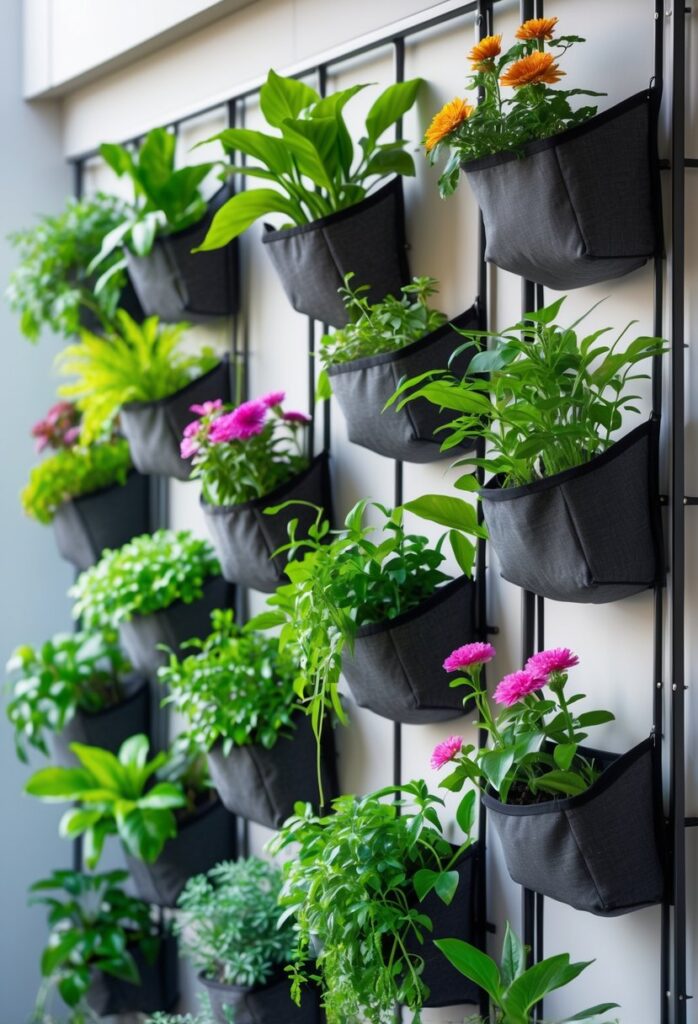
Hanging pocket planters are a popular choice for vertical gardens. They use multiple pockets or small containers attached to a backing material. This design allows many plants to grow in a small space on walls or fences.
These planters are lightweight and easy to install indoors or outdoors. They work well for herbs, flowers, and small vegetables. The pockets hold soil and water, helping plants grow efficiently.
Because they hang vertically, they save floor space. This makes them ideal for balconies, patios, or small yards. Many options have 16 or more pockets, providing room for a variety of plants in one setup.
Materials often include fabric or plastic. Fabric pockets allow for drainage and air flow, which can benefit root health. Plastic versions tend to be more durable and weather-resistant.
For those interested in a 16-pocket option, several products are available that combine durability with ease of use. These can be found in different sizes and designs to match different garden areas and styles, like the 16-pocket vertical garden planters seen on sites such as Amazon.
7) Vertical Straw Bale Garden
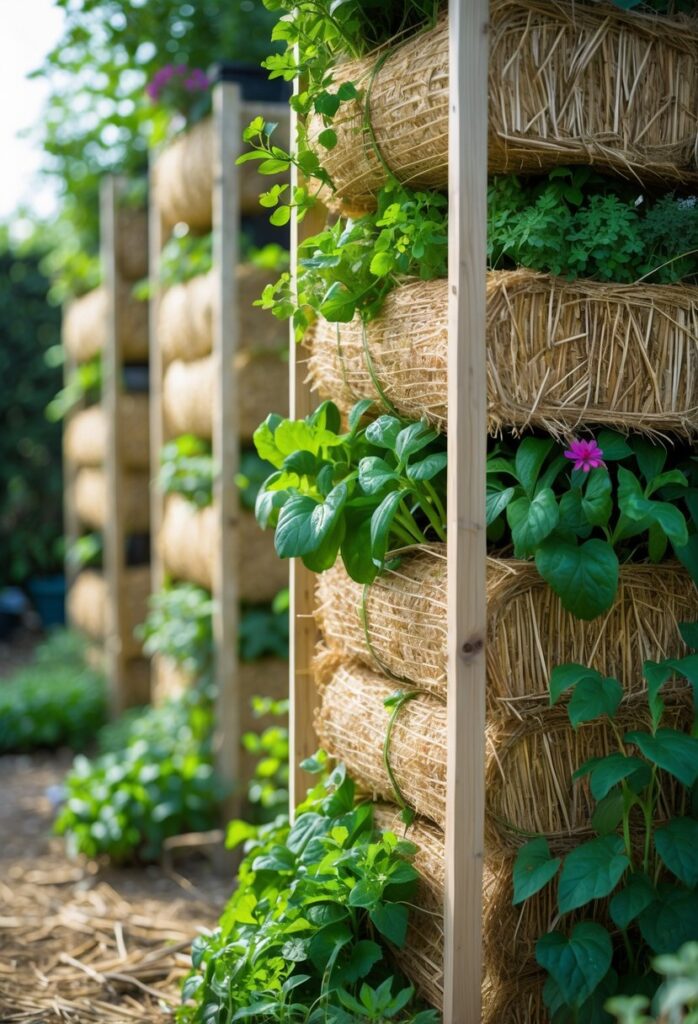
A vertical straw bale garden uses stacked straw bales as a growing space. This method is ideal for people with limited space, like those in urban areas or with small yards. It allows gardeners to grow plants upward instead of spreading out horizontally.
Straw bales are easy to find and affordable. They provide good drainage and can hold moisture well, which helps plants grow. Gardeners can plant vegetables, herbs, and flowers directly into the bales once they are conditioned.
Adding a trellis or wire support helps plants climb and grow vertically. This gives the garden extra height and saves space. It also makes harvesting easier since plants are more accessible. Vertical straw bale gardens combine container and vertical gardening techniques for efficient use of space.
More detailed tips on setup and maintenance are available in guides about vertical straw bale gardening.
8) PVC Pipe Planters
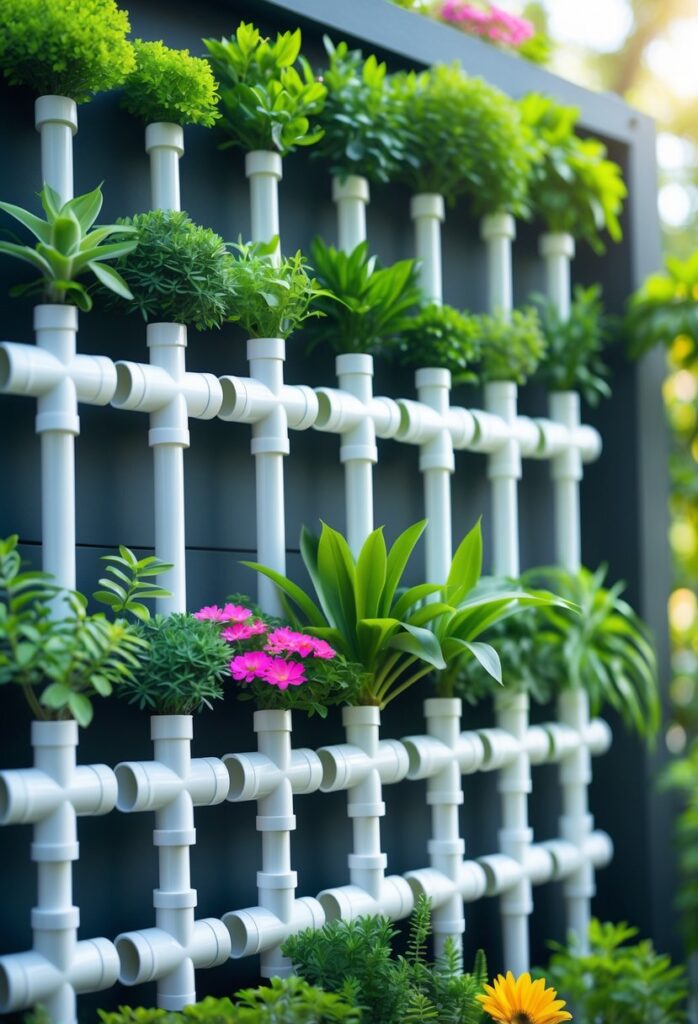
PVC pipe planters are a practical choice for building a vertical garden. They are lightweight, affordable, and easy to cut and shape. This makes them perfect for use in small spaces or urban gardens.
These planters allow gardeners to grow many plants vertically, saving ground space. By drilling drainage holes along the pipes, roots get enough air and water does not pool inside. This helps keep plants healthy.
Gardeners can fill the pipes with soil and plant herbs, vegetables, or flowers. The simple design fits well in tight corners or along walls. It also has a clean, modern look.
Setting up involves attaching PVC pipes vertically to a wall or frame. Gardeners often add gravel or an irrigation pipe inside for stability and watering. Some decorate the pipes with string lights for added style.
PVC pipe planters require regular watering, especially in warmer weather. Checking soil moisture often supports steady plant growth. This method offers a flexible and space-saving way to garden at home. More details are available in a guide on making a vertical PVC pipe garden.
9) Repurposed Shoe Organizer Garden
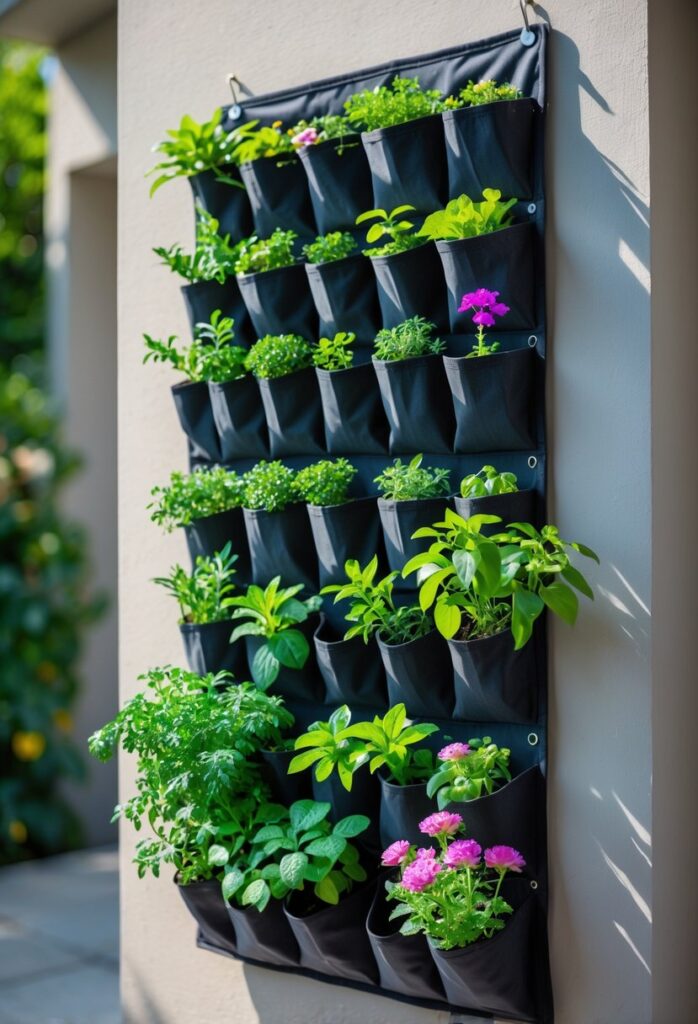
A shoe organizer can be turned into a simple vertical garden. It has many pockets that hold soil and plants. This makes it easy to grow small herbs, flowers, or vegetables in a small space.
People often hang shoe organizers on walls or fences. This saves floor space and adds greenery to places that might not get much use. It works well in spots with good sunlight.
To keep plants healthy, holes can be made in each pocket for drainage. The organizer’s lightweight material makes it easy to move or rearrange if needed. It is also a low-cost way to start a garden.
This type of garden works well for herbs like basil, mint, and parsley. It can also support annual flowers or small greens. Using a shoe organizer for vertical gardening is practical and efficient for limited spaces.
More detailed tips on this idea can be found in the article about how to turn a shoe organizer into a vertical garden.
10) Wall-Mounted Succulent Grid
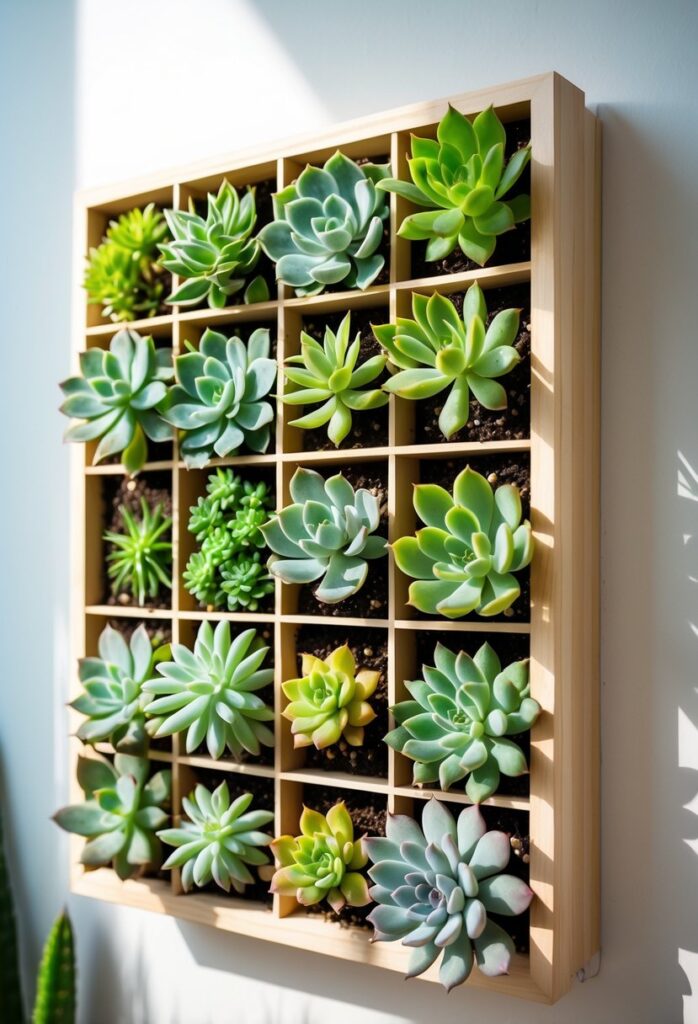
A wall-mounted succulent grid is a smart way to display succulents vertically. It uses small pots or containers arranged in a grid pattern on a wall. This setup makes it easy to organize many plants in a small space.
The grid allows for good air circulation and sunlight access for each succulent. Plants can be replaced or moved without disturbing others. This flexibility helps keep the display fresh and healthy.
Installing a succulent grid usually requires a sturdy frame and simple mounting hardware. Some grids are designed for quick hanging so the plants can root on the wall faster. This makes creating a living wall more accessible for beginners.
Succulent grids work well indoors or outdoors, adding greenery without taking up floor space. They also allow for creative designs with various shapes and colors of succulents. More ideas on vertical succulent gardens are available at 20 best wall planters for a vertical succulent garden.
11) Living Wall with Moss Art
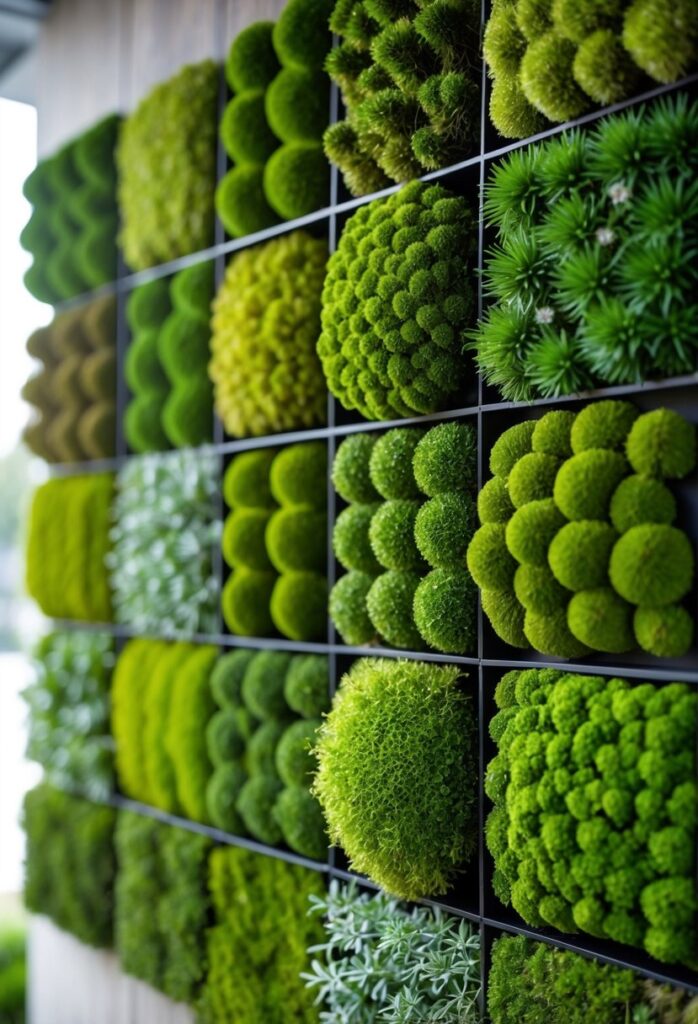
A living wall with moss art uses preserved or live moss to create natural designs on vertical surfaces. It adds a calming, green element to any room without needing much care.
Moss art can be simple patterns or detailed images. It brings texture and depth that change the feel of an indoor space.
This type of wall is low maintenance compared to other plants. Preserved moss does not require watering, making it ideal for busy or low-light areas.
Moss walls also help improve air quality by trapping dust and moisture. They add a natural touch while fitting well in modern or rustic decor.
For ideas on creating or buying moss wall art, one can find inspiration and guidance on making custom pieces that suit different tastes and spaces. More details about living moss walls and designs are available at living moss walls and moss wall art websites.
12) Balcony Rail Herb Garden

A balcony rail herb garden is a smart way to use limited outdoor space. It allows for growing fresh herbs without taking up floor space. People can mount long planter boxes directly on balcony railings.
This setup keeps herbs within easy reach while freeing up room for seating or storage. It also helps herbs get plenty of sunlight and fresh air. Choosing sturdy materials for planters and mounting hardware is important for safety and durability.
Herbs such as basil, mint, and rosemary work well in these rail gardens. They can thrive with regular watering and occasional feeding. Proper drainage in the planter boxes prevents water buildup and root problems.
With a little planning, the balcony rail becomes a productive spot for fresh, homegrown herbs. This vertical approach suits renters and people with small outdoor areas. More tips on creating this garden style can be found in ideas for installing vertical herb gardens on balcony railings.
13) DIY Ladder Plant Shelf
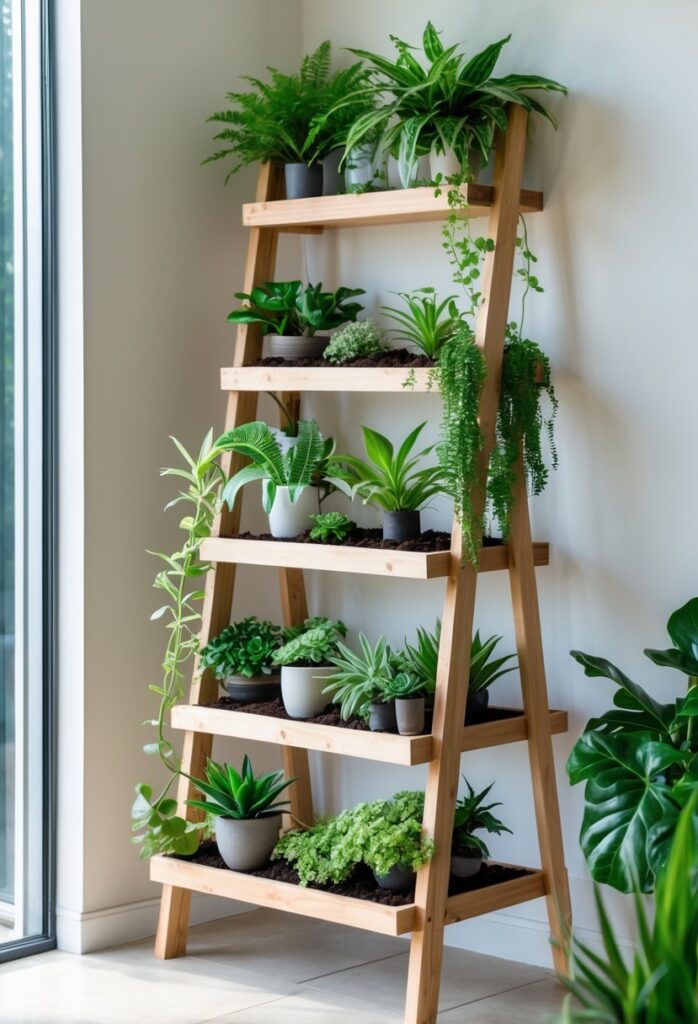
A DIY ladder plant shelf is a practical way to add vertical gardening space. It works well both indoors and outdoors, fitting into small areas like balconies, patios, or even living rooms.
The design uses a simple ladder frame with wooden planks set as shelves. This setup holds multiple pots and allows plants to receive light evenly.
Using leftover wood or an old ladder makes this project budget-friendly and eco-friendly. The shelves can be arranged at different heights to fit plants of various sizes.
This type of plant shelf helps organize greenery neatly. It also makes watering and plant care easier because everything is within reach.
Adding a DIY ladder plant shelf can enhance a space by creating a focused display of plants. It offers a chance to use vertical space efficiently, which is key in small gardens or urban homes.
For detailed plans and ideas, many guides show step-by-step instructions on how to build and customize ladder plant shelves. One such resource offers DIY ladder shelf planter ideas.
14) Stacked Concrete Block Garden
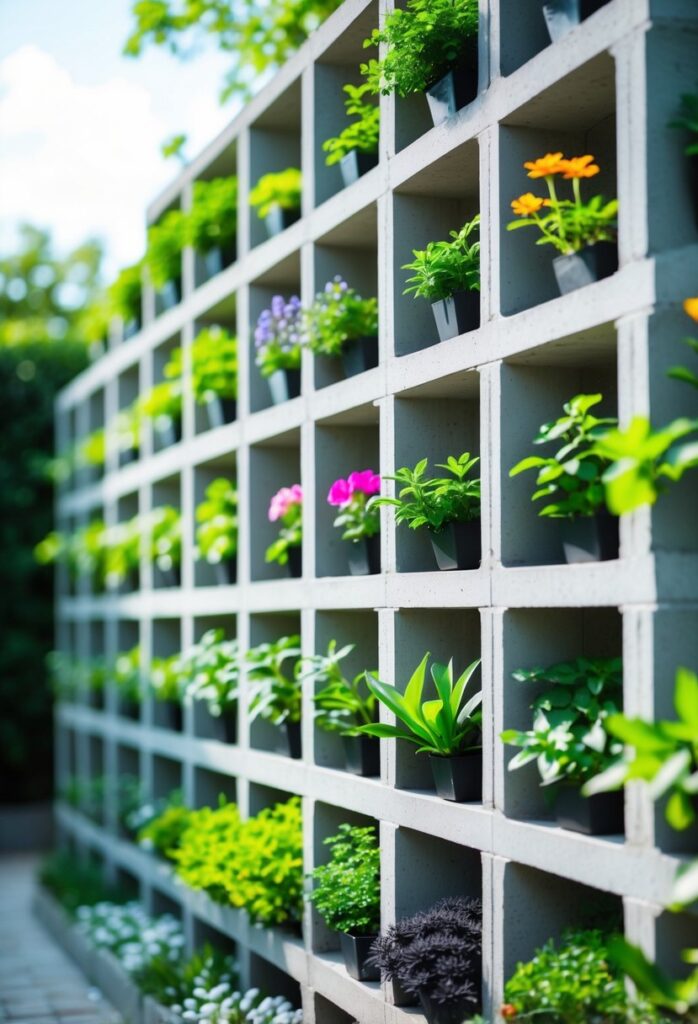
Stacked concrete blocks offer a simple and sturdy way to create a vertical garden. The hollow centers of the blocks act as natural planting pockets. This makes it easy to grow herbs, flowers, or small vegetables in a compact space.
The blocks can be arranged in several patterns. Stacking them with open cores facing out allows plants to grow directly from the block. Some gardeners use rebar to secure the blocks for added stability and durability.
This method also provides good drainage. Excess water can quickly pass through the openings, reducing the risk of root rot. The concrete blocks are weather-resistant, which helps the structure last for many years.
Additionally, stacked block gardens can serve as a decorative feature. Painting or arranging blocks creatively can add visual interest to patios or backyards. For more details on designs and techniques, see this guide on creating vertical gardens with concrete blocks.
15) Hanging Macrame Plant Holders
Hanging macrame plant holders offer a stylish way to display plants while saving floor space. They can hold one or multiple pots, often stacked vertically to maximize use of small areas. This makes them ideal for apartments or rooms with limited room.
The materials used are usually cotton or jute cords, tied into decorative knots. These knots form a sturdy cradle for pots and allow air to circulate around the plants. Some designs also include wooden rings or beads for added support and style.
Macrame hangers can be used indoors or outdoors. They bring a natural, boho touch to any space when hung near windows, in corners, or on walls. Mixing different sizes and heights of macrame hangers can create an attractive layered look.
There are many free patterns available for those who want to make their own. Beginners can start with simple knots, while advanced crafters can try more complex designs. Instructions and ideas can be found on websites with detailed macrame plant hanger guides.
For more examples, visit this collection of macrame plant hanger patterns or explore multi-tiered macrame plant hangers.
16) Vertical Strawberry Planter
A vertical strawberry planter is a smart way to grow strawberries in small spaces. It allows gardeners to use height instead of ground area, making it ideal for balconies, patios, or small yards.
These planters often come in stackable or hanging designs. This setup helps keep the berries off the soil, reducing the risk of pests and diseases.
Strawberries grow well in vertical systems because they need good air circulation and drainage. Growing this way also makes harvesting easier, as the fruits are more visible and accessible.
Many vertical strawberry planters are made from durable materials like lightweight plastic. Some models even have wheels or hooks for easy movement and adjustment.
Using a vertical strawberry planter can lead to multiple harvests if properly cared for. It is important to water the plants regularly and provide enough sunlight for healthy growth.
To learn more about vertical options, one can explore detailed guides on how to grow strawberries vertically or check reviews of popular vertical planters designed specifically for strawberries.
Benefits of a 16 Vertical Garden
A 16 vertical garden makes efficient use of space while improving air quality and adding style. It combines practical advantages with visual appeal, making it a smart choice for both indoor and outdoor settings.
Space Optimization
A 16 vertical garden is designed to grow plants upward rather than outward. This allows gardeners to save a lot of ground space, which is especially helpful in small homes, apartments, or urban areas.
By stacking plants vertically, it can hold many different species in a compact footprint. This means more plants can be grown in less space without overcrowding.
This use of vertical space also makes gardening possible in places where traditional gardens are not feasible, such as balconies, patios, or walls inside the home. It maximizes growing area efficiently while keeping plants accessible.
Improved Air Quality
Plants in a 16 vertical garden help improve indoor or outdoor air quality by absorbing carbon dioxide and releasing oxygen. This contributes to fresher and healthier air around the garden.
Many plants used in vertical gardens also filter pollutants and toxins from the air. This ability can reduce dust and other allergens, making the environment cleaner and safer.
The arrangement encourages airflow and sunlight exposure, which helps plants stay healthy and boosts their natural air-purifying effects. This benefit is especially valuable in dense living spaces.
Aesthetic Versatility
A 16 vertical garden adds a unique visual element to any space. Its vertical arrangement can create living walls, colorful displays, or natural dividers that enhance the area’s look.
It suits many design styles, from modern to rustic, because plants can be arranged in patterns, shapes, or mixed with decorative elements.
This versatility lets it function as focal points, privacy screens, or natural insulation. Its aesthetic appeal also increases property value and adds a calming, green ambiance indoors or outdoors.
For more details, see the benefits of vertical gardens in small landscapes at Live to Plant.
Installation and Maintenance Tips
Installing a vertical garden requires careful planning, especially regarding the garden’s location, watering method, and soil quality. Proper attention to these factors will ensure plants grow well and the structure remains durable over time.
Site Selection
Choosing the right location is key to a healthy vertical garden. It should get enough natural sunlight, usually about 4-6 hours daily, depending on the plants chosen. Avoid places with harsh afternoon sun if the plants are sensitive.
The site also needs good access for watering and maintenance. Walls that can support the weight of the garden, like brick or concrete, work best. Avoid locations exposed to strong winds which can dry out or damage plants.
Space should allow for air circulation to prevent mold or mildew. If indoors, placing the garden near a window will help plants thrive without needing extra grow lights.
Watering Solutions
Watering a vertical garden is tricky since gravity pulls water downward. A drip irrigation system is ideal for even moisture distribution and is easier to control. Timers can automate watering, reducing risk of over- or underwatering.
Hand watering is possible but requires attention to avoid water pooling at the bottom. Using moisture-retentive mats inside planting pockets can help retain water longer.
Drainage is important to prevent root rot. A setup with proper drainage holes or trays helps excess water escape safely.
Soil and Fertilizer Recommendations
Use a lightweight, well-draining soil mix designed for vertical gardens. Regular garden soil is often too heavy and can suffocate roots. A mix with peat moss, perlite, and compost is best for moisture retention and aeration.
Plants in vertical gardens need regular feeding because nutrients wash away faster from vertical beds. A balanced, slow-release fertilizer with equal nitrogen, phosphorus, and potassium supports steady growth.
Liquid fertilizers can be added through irrigation in small doses every 2-4 weeks. Avoid over-fertilizing, as this can harm roots or cause nutrient buildup.
Frequently Asked Questions
Vertical gardens need specific types of plants, careful watering methods, and proper light to thrive. They also require regular care and a stable structure to hold the plants and soil in place.
What are the best plants to use for a vertical garden in small spaces?
Small spaces work well with compact plants like herbs (basil, thyme), succulents, and strawberries. Climbing vegetables such as peas and beans are good for trellises. Plants with shallow roots fit best in limited soil areas.
How do I water my vertical garden efficiently?
Vertical gardens dry out faster due to shallow soil, so frequent watering is important. Using drip irrigation or a built-in watering system helps deliver water evenly. It’s best to water from top to bottom to ensure all plants get moisture.
Can vertical gardens be installed indoors, and if so, what are the considerations?
Yes, vertical gardens can be indoors. They need enough light, either natural or from grow lights. Proper humidity and air circulation help prevent mold and pests. Using lightweight materials and waterproof backing is important to protect walls.
What is the typical maintenance routine for a vertical garden?
Regular tasks include checking for pests, pruning plants to control growth, and fertilizing every few weeks. Plants should be inspected often because vertical gardens have less soil for nutrients. Removing dead leaves keeps the garden healthy.
How can I ensure proper sunlight exposure for my vertical garden?
Place the garden where it receives several hours of indirect or direct sunlight depending on the plants used. South-facing walls usually get good sun, but some shade is helpful for sensitive plants. Rotate or move movable planters if needed.
What are the structural requirements for installing a vertical garden?
The wall or structure must support the weight of plants, soil, and water. Using sturdy frames like wooden pallets or metal grids works well. Waterproof membranes prevent damage to walls, and secure mounting is essential to keep the garden stable.
For more details, see this page on vertical garden frequently asked questions.
